Developing Individuals, Teams, and Organisations Report - HND Business
VerifiedAdded on 2022/12/23
|14
|3593
|95
Report
AI Summary
This report provides a comprehensive analysis of developing individuals, teams, and organizations, focusing on the context of Royal Mail. It delves into the desired professional roles for HR managers, conducting a personal skills audit and outlining a professional development plan. The report explores the distinctions between organizational and individual learning, training, and development, emphasizing the need for continuous learning and applying learning cycle theories, including Kolb's and Honey and Mumford's models. It also examines high-performance work (HPW), analyzing its benefits in terms of employee engagement, commitment, and competitive advantage, and evaluates various performance management approaches. The report concludes by highlighting how HPW, collaborative working, and effective communication can foster a high-performance culture and commitment within the organization.
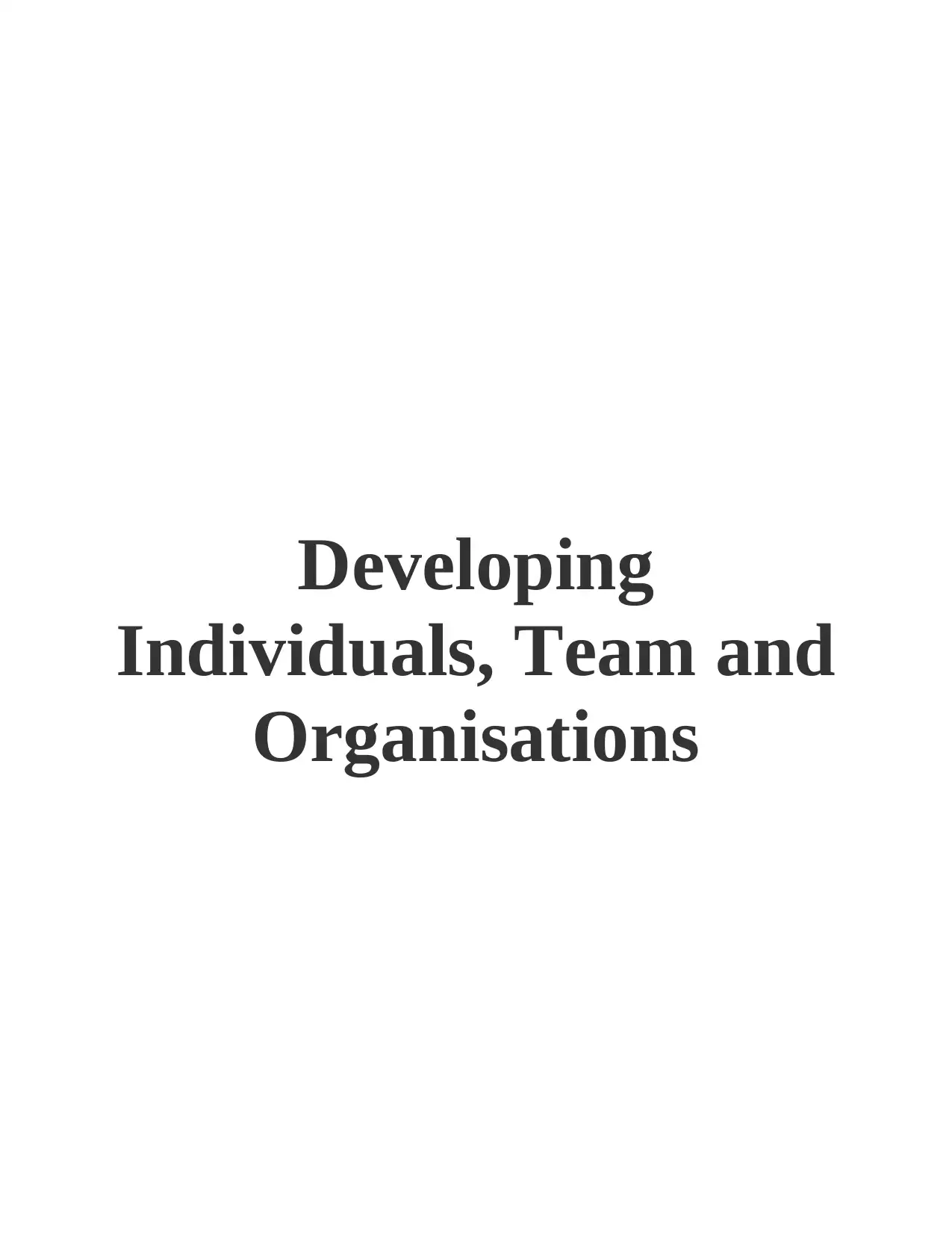
Developing
Individuals, Team and
Organisations
Individuals, Team and
Organisations
Paraphrase This Document
Need a fresh take? Get an instant paraphrase of this document with our AI Paraphraser
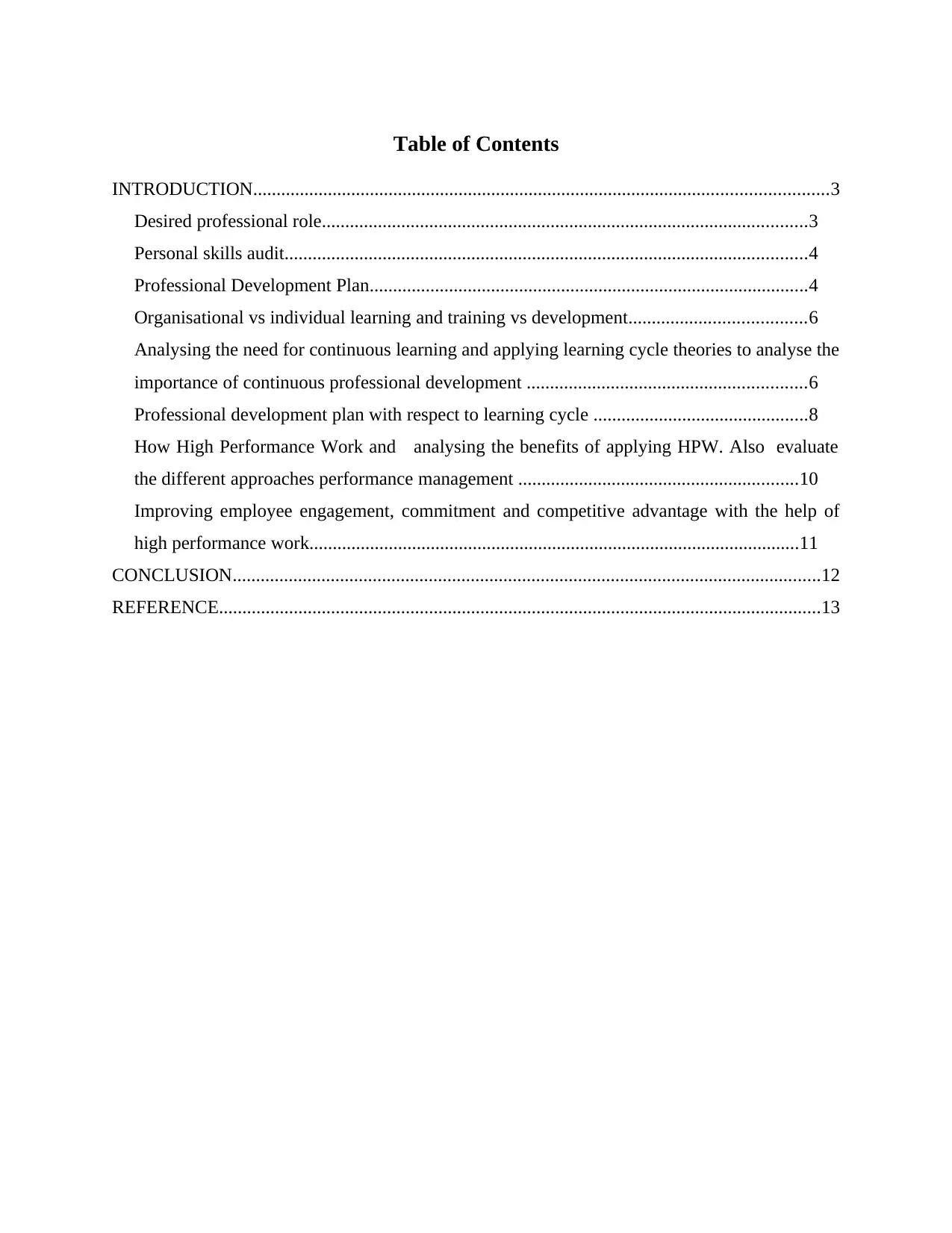
Table of Contents
INTRODUCTION...........................................................................................................................3
Desired professional role........................................................................................................3
Personal skills audit................................................................................................................4
Professional Development Plan..............................................................................................4
Organisational vs individual learning and training vs development......................................6
Analysing the need for continuous learning and applying learning cycle theories to analyse the
importance of continuous professional development ............................................................6
Professional development plan with respect to learning cycle ..............................................8
How High Performance Work and analysing the benefits of applying HPW. Also evaluate
the different approaches performance management ............................................................10
Improving employee engagement, commitment and competitive advantage with the help of
high performance work.........................................................................................................11
CONCLUSION..............................................................................................................................12
REFERENCE.................................................................................................................................13
INTRODUCTION...........................................................................................................................3
Desired professional role........................................................................................................3
Personal skills audit................................................................................................................4
Professional Development Plan..............................................................................................4
Organisational vs individual learning and training vs development......................................6
Analysing the need for continuous learning and applying learning cycle theories to analyse the
importance of continuous professional development ............................................................6
Professional development plan with respect to learning cycle ..............................................8
How High Performance Work and analysing the benefits of applying HPW. Also evaluate
the different approaches performance management ............................................................10
Improving employee engagement, commitment and competitive advantage with the help of
high performance work.........................................................................................................11
CONCLUSION..............................................................................................................................12
REFERENCE.................................................................................................................................13
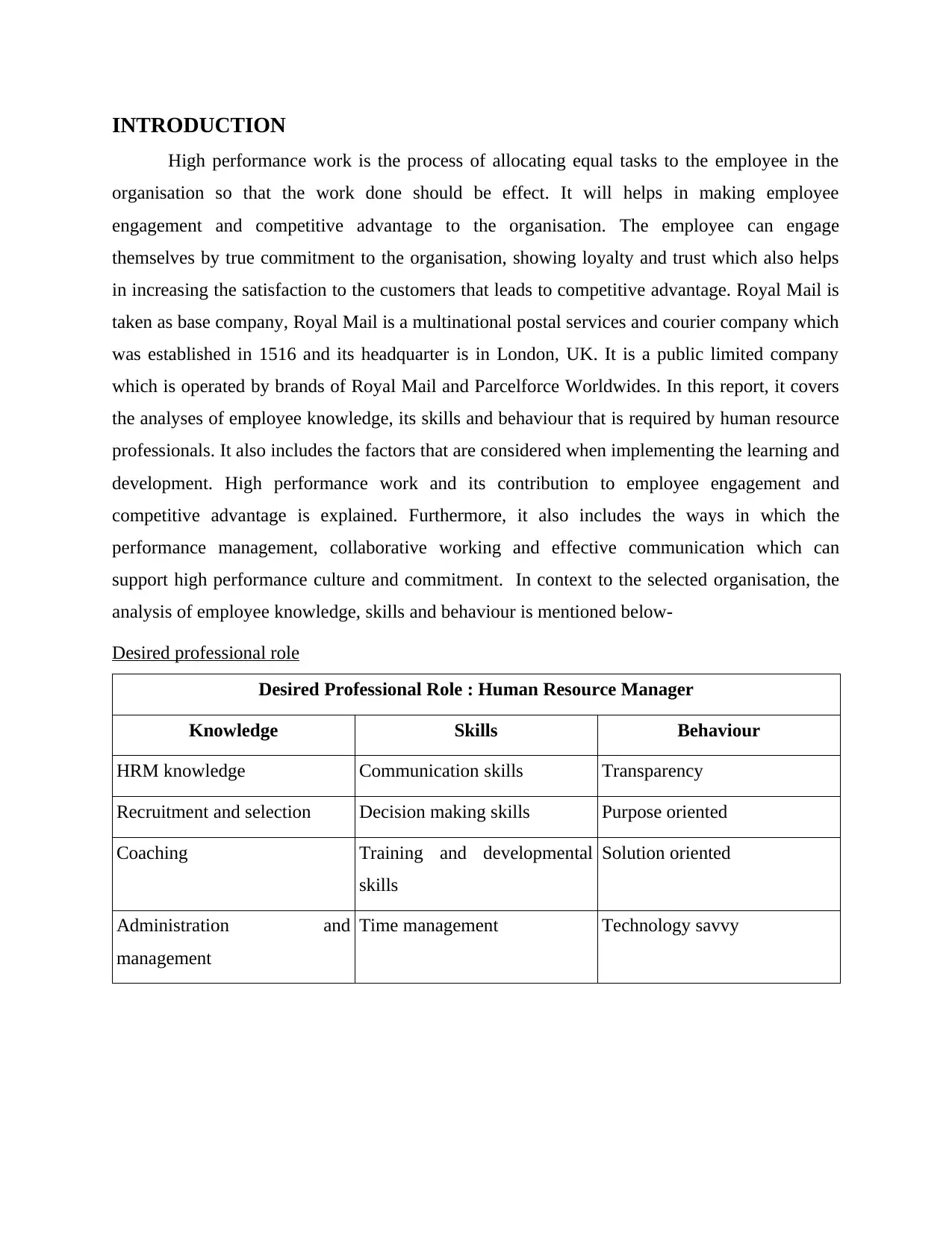
INTRODUCTION
High performance work is the process of allocating equal tasks to the employee in the
organisation so that the work done should be effect. It will helps in making employee
engagement and competitive advantage to the organisation. The employee can engage
themselves by true commitment to the organisation, showing loyalty and trust which also helps
in increasing the satisfaction to the customers that leads to competitive advantage. Royal Mail is
taken as base company, Royal Mail is a multinational postal services and courier company which
was established in 1516 and its headquarter is in London, UK. It is a public limited company
which is operated by brands of Royal Mail and Parcelforce Worldwides. In this report, it covers
the analyses of employee knowledge, its skills and behaviour that is required by human resource
professionals. It also includes the factors that are considered when implementing the learning and
development. High performance work and its contribution to employee engagement and
competitive advantage is explained. Furthermore, it also includes the ways in which the
performance management, collaborative working and effective communication which can
support high performance culture and commitment. In context to the selected organisation, the
analysis of employee knowledge, skills and behaviour is mentioned below-
Desired professional role
Desired Professional Role : Human Resource Manager
Knowledge Skills Behaviour
HRM knowledge Communication skills Transparency
Recruitment and selection Decision making skills Purpose oriented
Coaching Training and developmental
skills
Solution oriented
Administration and
management
Time management Technology savvy
High performance work is the process of allocating equal tasks to the employee in the
organisation so that the work done should be effect. It will helps in making employee
engagement and competitive advantage to the organisation. The employee can engage
themselves by true commitment to the organisation, showing loyalty and trust which also helps
in increasing the satisfaction to the customers that leads to competitive advantage. Royal Mail is
taken as base company, Royal Mail is a multinational postal services and courier company which
was established in 1516 and its headquarter is in London, UK. It is a public limited company
which is operated by brands of Royal Mail and Parcelforce Worldwides. In this report, it covers
the analyses of employee knowledge, its skills and behaviour that is required by human resource
professionals. It also includes the factors that are considered when implementing the learning and
development. High performance work and its contribution to employee engagement and
competitive advantage is explained. Furthermore, it also includes the ways in which the
performance management, collaborative working and effective communication which can
support high performance culture and commitment. In context to the selected organisation, the
analysis of employee knowledge, skills and behaviour is mentioned below-
Desired professional role
Desired Professional Role : Human Resource Manager
Knowledge Skills Behaviour
HRM knowledge Communication skills Transparency
Recruitment and selection Decision making skills Purpose oriented
Coaching Training and developmental
skills
Solution oriented
Administration and
management
Time management Technology savvy
⊘ This is a preview!⊘
Do you want full access?
Subscribe today to unlock all pages.

Trusted by 1+ million students worldwide
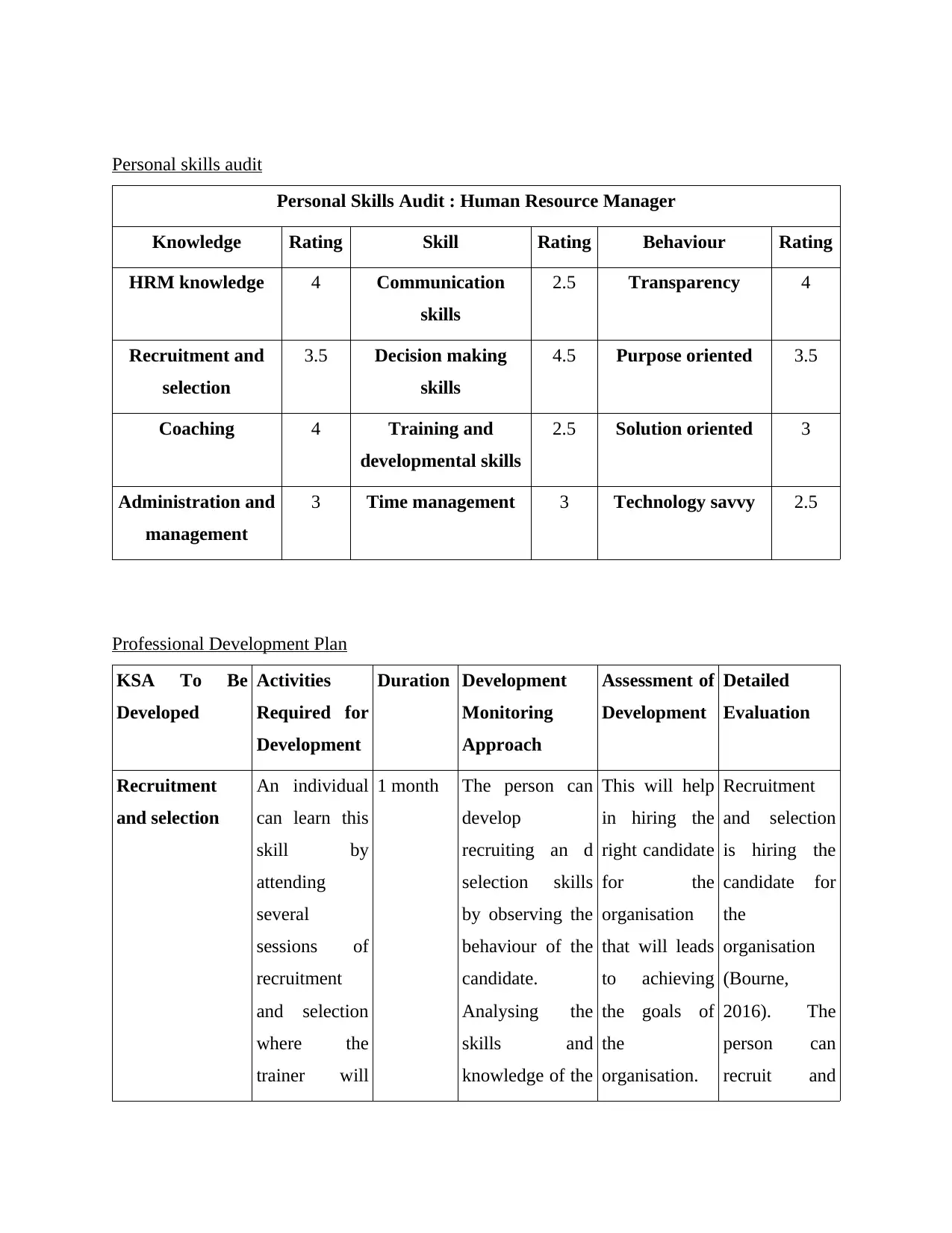
Personal skills audit
Personal Skills Audit : Human Resource Manager
Knowledge Rating Skill Rating Behaviour Rating
HRM knowledge 4 Communication
skills
2.5 Transparency 4
Recruitment and
selection
3.5 Decision making
skills
4.5 Purpose oriented 3.5
Coaching 4 Training and
developmental skills
2.5 Solution oriented 3
Administration and
management
3 Time management 3 Technology savvy 2.5
Professional Development Plan
KSA To Be
Developed
Activities
Required for
Development
Duration Development
Monitoring
Approach
Assessment of
Development
Detailed
Evaluation
Recruitment
and selection
An individual
can learn this
skill by
attending
several
sessions of
recruitment
and selection
where the
trainer will
1 month The person can
develop
recruiting an d
selection skills
by observing the
behaviour of the
candidate.
Analysing the
skills and
knowledge of the
This will help
in hiring the
right candidate
for the
organisation
that will leads
to achieving
the goals of
the
organisation.
Recruitment
and selection
is hiring the
candidate for
the
organisation
(Bourne,
2016). The
person can
recruit and
Personal Skills Audit : Human Resource Manager
Knowledge Rating Skill Rating Behaviour Rating
HRM knowledge 4 Communication
skills
2.5 Transparency 4
Recruitment and
selection
3.5 Decision making
skills
4.5 Purpose oriented 3.5
Coaching 4 Training and
developmental skills
2.5 Solution oriented 3
Administration and
management
3 Time management 3 Technology savvy 2.5
Professional Development Plan
KSA To Be
Developed
Activities
Required for
Development
Duration Development
Monitoring
Approach
Assessment of
Development
Detailed
Evaluation
Recruitment
and selection
An individual
can learn this
skill by
attending
several
sessions of
recruitment
and selection
where the
trainer will
1 month The person can
develop
recruiting an d
selection skills
by observing the
behaviour of the
candidate.
Analysing the
skills and
knowledge of the
This will help
in hiring the
right candidate
for the
organisation
that will leads
to achieving
the goals of
the
organisation.
Recruitment
and selection
is hiring the
candidate for
the
organisation
(Bourne,
2016). The
person can
recruit and
Paraphrase This Document
Need a fresh take? Get an instant paraphrase of this document with our AI Paraphraser
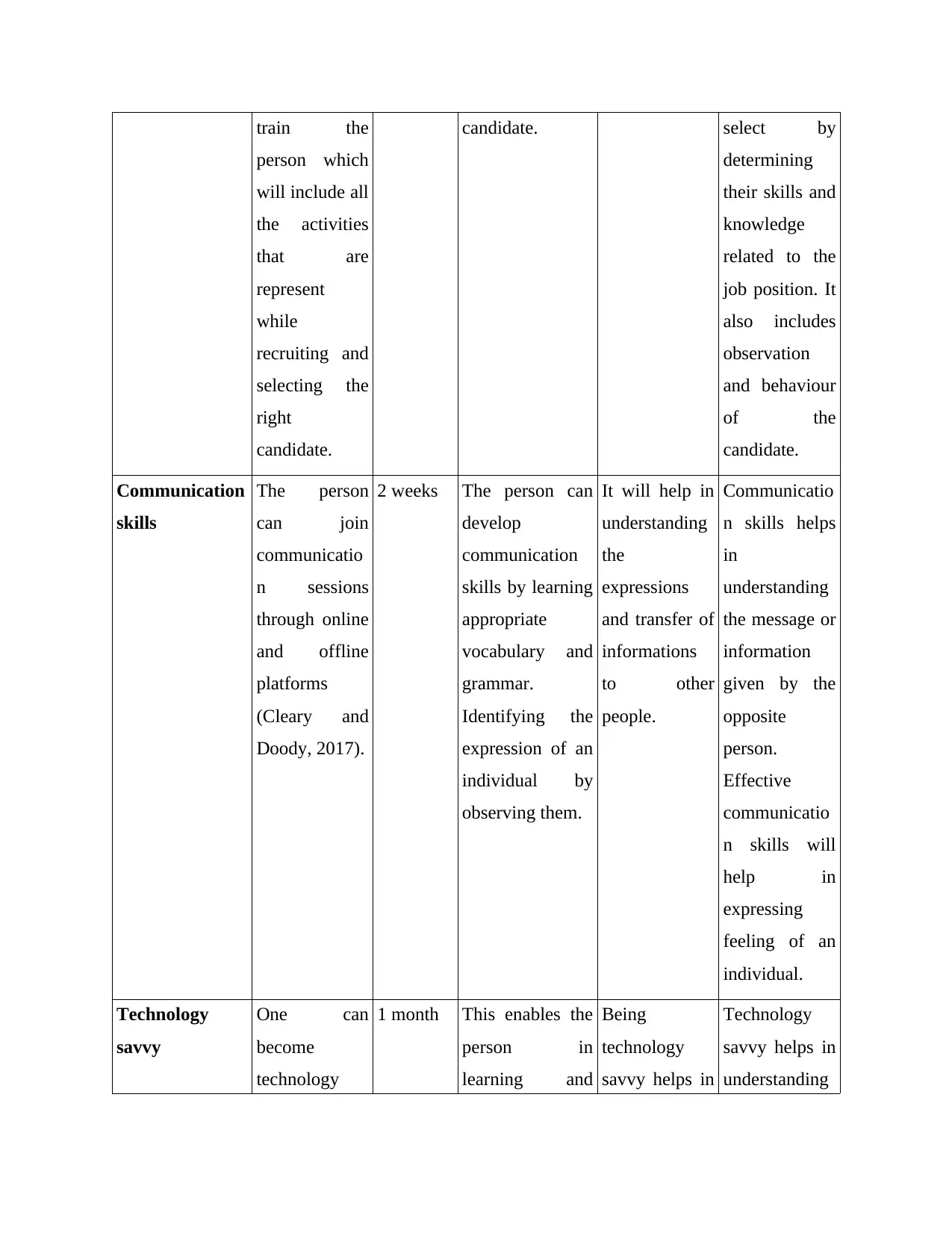
train the
person which
will include all
the activities
that are
represent
while
recruiting and
selecting the
right
candidate.
candidate. select by
determining
their skills and
knowledge
related to the
job position. It
also includes
observation
and behaviour
of the
candidate.
Communication
skills
The person
can join
communicatio
n sessions
through online
and offline
platforms
(Cleary and
Doody, 2017).
2 weeks The person can
develop
communication
skills by learning
appropriate
vocabulary and
grammar.
Identifying the
expression of an
individual by
observing them.
It will help in
understanding
the
expressions
and transfer of
informations
to other
people.
Communicatio
n skills helps
in
understanding
the message or
information
given by the
opposite
person.
Effective
communicatio
n skills will
help in
expressing
feeling of an
individual.
Technology
savvy
One can
become
technology
1 month This enables the
person in
learning and
Being
technology
savvy helps in
Technology
savvy helps in
understanding
person which
will include all
the activities
that are
represent
while
recruiting and
selecting the
right
candidate.
candidate. select by
determining
their skills and
knowledge
related to the
job position. It
also includes
observation
and behaviour
of the
candidate.
Communication
skills
The person
can join
communicatio
n sessions
through online
and offline
platforms
(Cleary and
Doody, 2017).
2 weeks The person can
develop
communication
skills by learning
appropriate
vocabulary and
grammar.
Identifying the
expression of an
individual by
observing them.
It will help in
understanding
the
expressions
and transfer of
informations
to other
people.
Communicatio
n skills helps
in
understanding
the message or
information
given by the
opposite
person.
Effective
communicatio
n skills will
help in
expressing
feeling of an
individual.
Technology
savvy
One can
become
technology
1 month This enables the
person in
learning and
Being
technology
savvy helps in
Technology
savvy helps in
understanding
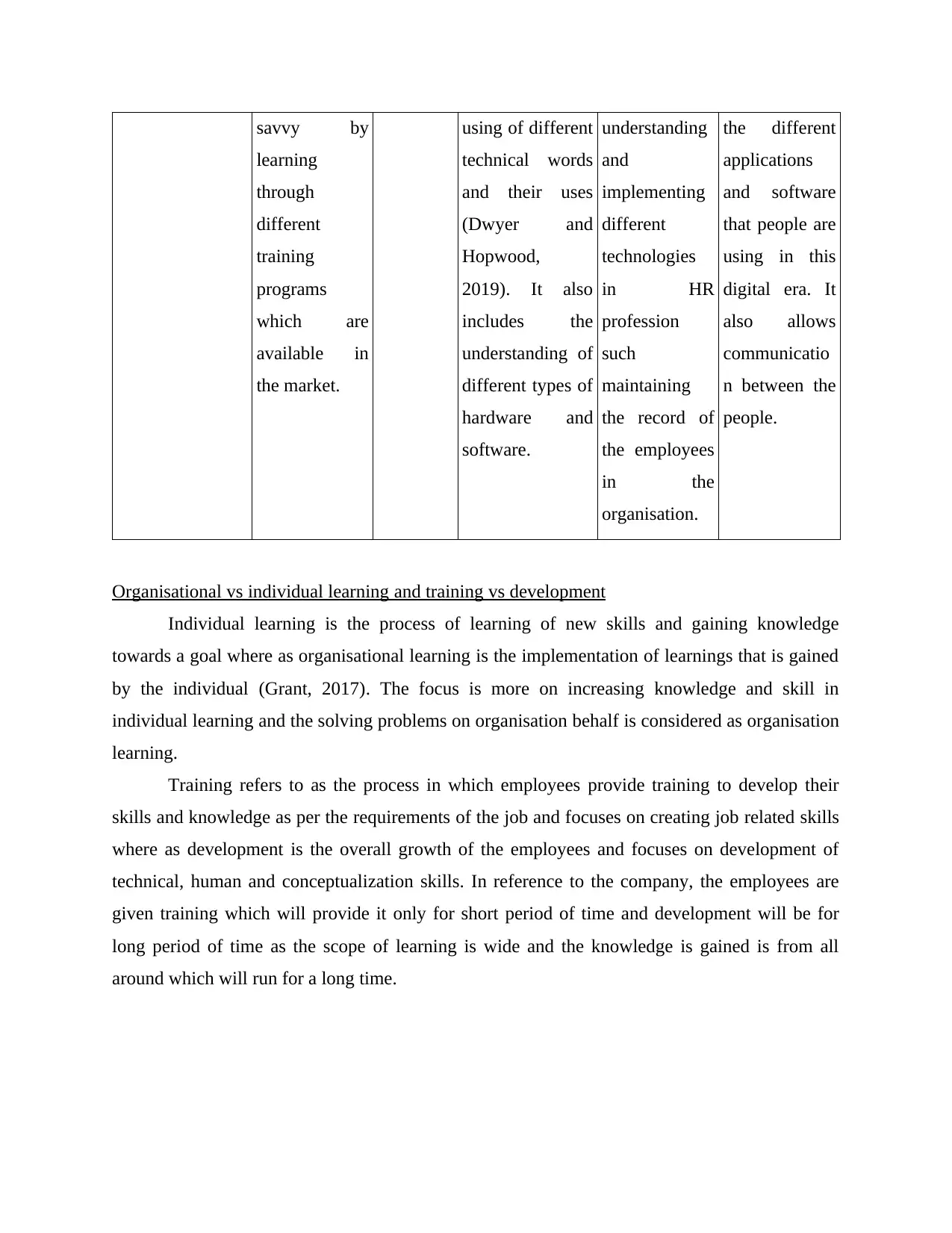
savvy by
learning
through
different
training
programs
which are
available in
the market.
using of different
technical words
and their uses
(Dwyer and
Hopwood,
2019). It also
includes the
understanding of
different types of
hardware and
software.
understanding
and
implementing
different
technologies
in HR
profession
such
maintaining
the record of
the employees
in the
organisation.
the different
applications
and software
that people are
using in this
digital era. It
also allows
communicatio
n between the
people.
Organisational vs individual learning and training vs development
Individual learning is the process of learning of new skills and gaining knowledge
towards a goal where as organisational learning is the implementation of learnings that is gained
by the individual (Grant, 2017). The focus is more on increasing knowledge and skill in
individual learning and the solving problems on organisation behalf is considered as organisation
learning.
Training refers to as the process in which employees provide training to develop their
skills and knowledge as per the requirements of the job and focuses on creating job related skills
where as development is the overall growth of the employees and focuses on development of
technical, human and conceptualization skills. In reference to the company, the employees are
given training which will provide it only for short period of time and development will be for
long period of time as the scope of learning is wide and the knowledge is gained is from all
around which will run for a long time.
learning
through
different
training
programs
which are
available in
the market.
using of different
technical words
and their uses
(Dwyer and
Hopwood,
2019). It also
includes the
understanding of
different types of
hardware and
software.
understanding
and
implementing
different
technologies
in HR
profession
such
maintaining
the record of
the employees
in the
organisation.
the different
applications
and software
that people are
using in this
digital era. It
also allows
communicatio
n between the
people.
Organisational vs individual learning and training vs development
Individual learning is the process of learning of new skills and gaining knowledge
towards a goal where as organisational learning is the implementation of learnings that is gained
by the individual (Grant, 2017). The focus is more on increasing knowledge and skill in
individual learning and the solving problems on organisation behalf is considered as organisation
learning.
Training refers to as the process in which employees provide training to develop their
skills and knowledge as per the requirements of the job and focuses on creating job related skills
where as development is the overall growth of the employees and focuses on development of
technical, human and conceptualization skills. In reference to the company, the employees are
given training which will provide it only for short period of time and development will be for
long period of time as the scope of learning is wide and the knowledge is gained is from all
around which will run for a long time.
⊘ This is a preview!⊘
Do you want full access?
Subscribe today to unlock all pages.

Trusted by 1+ million students worldwide
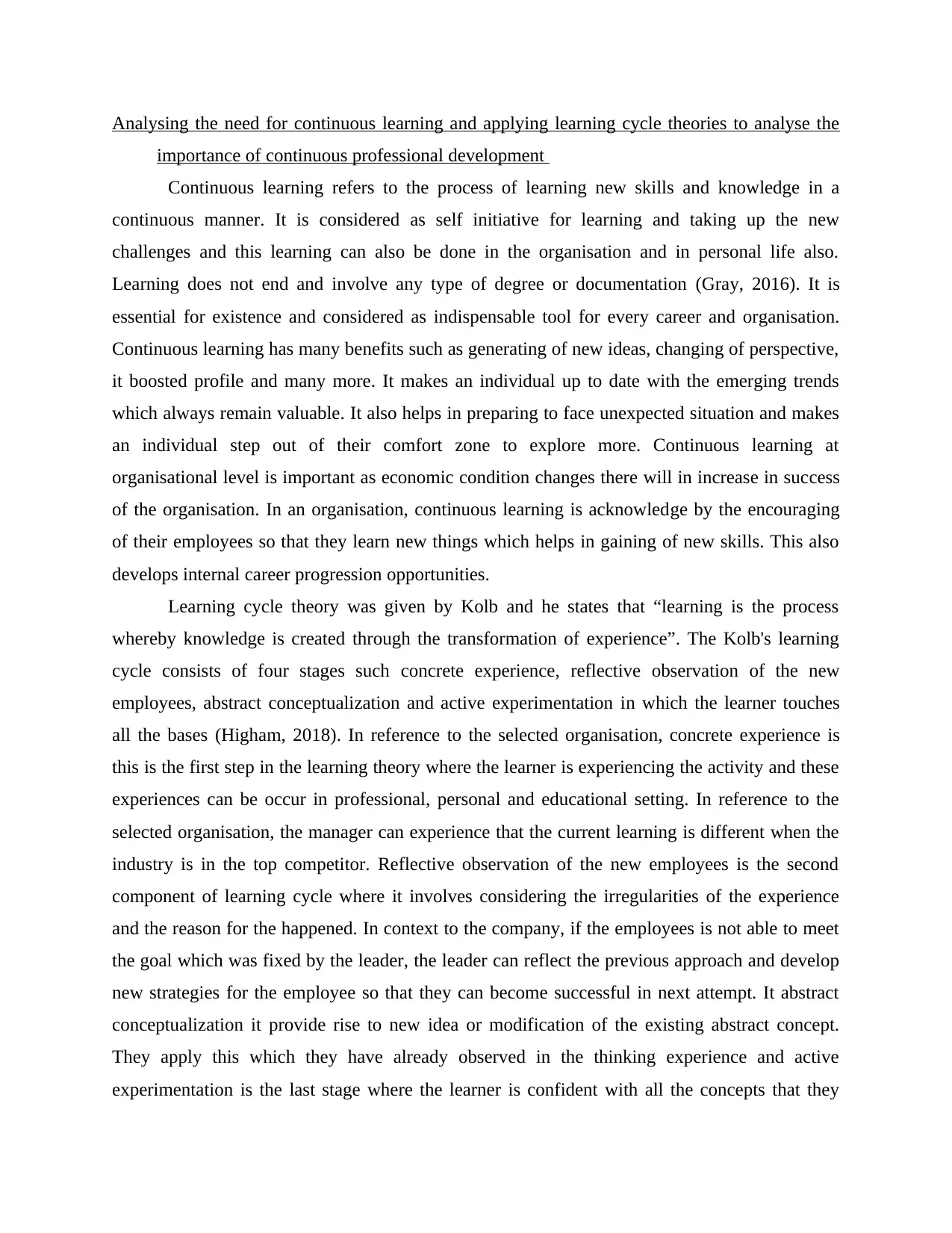
Analysing the need for continuous learning and applying learning cycle theories to analyse the
importance of continuous professional development
Continuous learning refers to the process of learning new skills and knowledge in a
continuous manner. It is considered as self initiative for learning and taking up the new
challenges and this learning can also be done in the organisation and in personal life also.
Learning does not end and involve any type of degree or documentation (Gray, 2016). It is
essential for existence and considered as indispensable tool for every career and organisation.
Continuous learning has many benefits such as generating of new ideas, changing of perspective,
it boosted profile and many more. It makes an individual up to date with the emerging trends
which always remain valuable. It also helps in preparing to face unexpected situation and makes
an individual step out of their comfort zone to explore more. Continuous learning at
organisational level is important as economic condition changes there will in increase in success
of the organisation. In an organisation, continuous learning is acknowledge by the encouraging
of their employees so that they learn new things which helps in gaining of new skills. This also
develops internal career progression opportunities.
Learning cycle theory was given by Kolb and he states that “learning is the process
whereby knowledge is created through the transformation of experience”. The Kolb's learning
cycle consists of four stages such concrete experience, reflective observation of the new
employees, abstract conceptualization and active experimentation in which the learner touches
all the bases (Higham, 2018). In reference to the selected organisation, concrete experience is
this is the first step in the learning theory where the learner is experiencing the activity and these
experiences can be occur in professional, personal and educational setting. In reference to the
selected organisation, the manager can experience that the current learning is different when the
industry is in the top competitor. Reflective observation of the new employees is the second
component of learning cycle where it involves considering the irregularities of the experience
and the reason for the happened. In context to the company, if the employees is not able to meet
the goal which was fixed by the leader, the leader can reflect the previous approach and develop
new strategies for the employee so that they can become successful in next attempt. It abstract
conceptualization it provide rise to new idea or modification of the existing abstract concept.
They apply this which they have already observed in the thinking experience and active
experimentation is the last stage where the learner is confident with all the concepts that they
importance of continuous professional development
Continuous learning refers to the process of learning new skills and knowledge in a
continuous manner. It is considered as self initiative for learning and taking up the new
challenges and this learning can also be done in the organisation and in personal life also.
Learning does not end and involve any type of degree or documentation (Gray, 2016). It is
essential for existence and considered as indispensable tool for every career and organisation.
Continuous learning has many benefits such as generating of new ideas, changing of perspective,
it boosted profile and many more. It makes an individual up to date with the emerging trends
which always remain valuable. It also helps in preparing to face unexpected situation and makes
an individual step out of their comfort zone to explore more. Continuous learning at
organisational level is important as economic condition changes there will in increase in success
of the organisation. In an organisation, continuous learning is acknowledge by the encouraging
of their employees so that they learn new things which helps in gaining of new skills. This also
develops internal career progression opportunities.
Learning cycle theory was given by Kolb and he states that “learning is the process
whereby knowledge is created through the transformation of experience”. The Kolb's learning
cycle consists of four stages such concrete experience, reflective observation of the new
employees, abstract conceptualization and active experimentation in which the learner touches
all the bases (Higham, 2018). In reference to the selected organisation, concrete experience is
this is the first step in the learning theory where the learner is experiencing the activity and these
experiences can be occur in professional, personal and educational setting. In reference to the
selected organisation, the manager can experience that the current learning is different when the
industry is in the top competitor. Reflective observation of the new employees is the second
component of learning cycle where it involves considering the irregularities of the experience
and the reason for the happened. In context to the company, if the employees is not able to meet
the goal which was fixed by the leader, the leader can reflect the previous approach and develop
new strategies for the employee so that they can become successful in next attempt. It abstract
conceptualization it provide rise to new idea or modification of the existing abstract concept.
They apply this which they have already observed in the thinking experience and active
experimentation is the last stage where the learner is confident with all the concepts that they
Paraphrase This Document
Need a fresh take? Get an instant paraphrase of this document with our AI Paraphraser
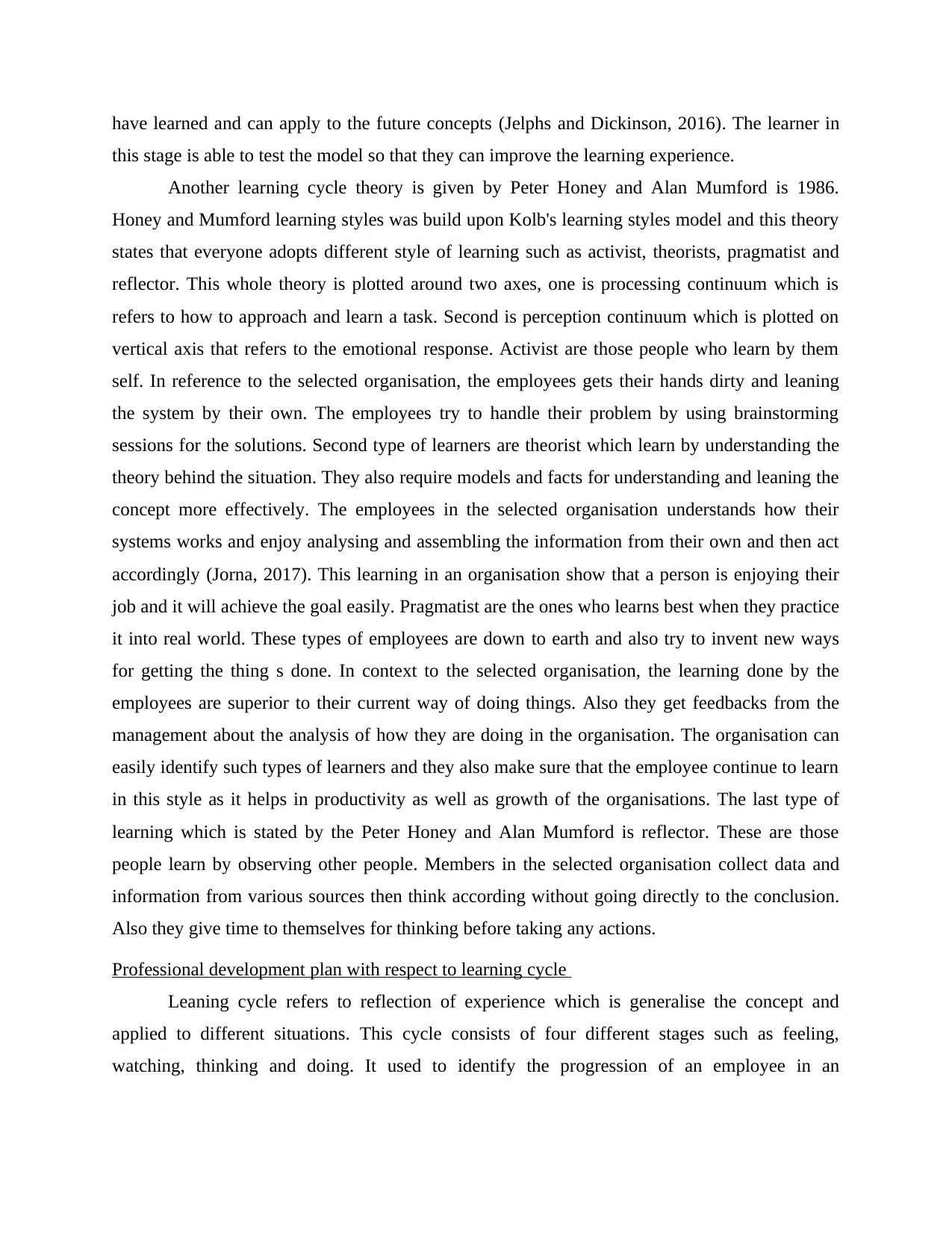
have learned and can apply to the future concepts (Jelphs and Dickinson, 2016). The learner in
this stage is able to test the model so that they can improve the learning experience.
Another learning cycle theory is given by Peter Honey and Alan Mumford is 1986.
Honey and Mumford learning styles was build upon Kolb's learning styles model and this theory
states that everyone adopts different style of learning such as activist, theorists, pragmatist and
reflector. This whole theory is plotted around two axes, one is processing continuum which is
refers to how to approach and learn a task. Second is perception continuum which is plotted on
vertical axis that refers to the emotional response. Activist are those people who learn by them
self. In reference to the selected organisation, the employees gets their hands dirty and leaning
the system by their own. The employees try to handle their problem by using brainstorming
sessions for the solutions. Second type of learners are theorist which learn by understanding the
theory behind the situation. They also require models and facts for understanding and leaning the
concept more effectively. The employees in the selected organisation understands how their
systems works and enjoy analysing and assembling the information from their own and then act
accordingly (Jorna, 2017). This learning in an organisation show that a person is enjoying their
job and it will achieve the goal easily. Pragmatist are the ones who learns best when they practice
it into real world. These types of employees are down to earth and also try to invent new ways
for getting the thing s done. In context to the selected organisation, the learning done by the
employees are superior to their current way of doing things. Also they get feedbacks from the
management about the analysis of how they are doing in the organisation. The organisation can
easily identify such types of learners and they also make sure that the employee continue to learn
in this style as it helps in productivity as well as growth of the organisations. The last type of
learning which is stated by the Peter Honey and Alan Mumford is reflector. These are those
people learn by observing other people. Members in the selected organisation collect data and
information from various sources then think according without going directly to the conclusion.
Also they give time to themselves for thinking before taking any actions.
Professional development plan with respect to learning cycle
Leaning cycle refers to reflection of experience which is generalise the concept and
applied to different situations. This cycle consists of four different stages such as feeling,
watching, thinking and doing. It used to identify the progression of an employee in an
this stage is able to test the model so that they can improve the learning experience.
Another learning cycle theory is given by Peter Honey and Alan Mumford is 1986.
Honey and Mumford learning styles was build upon Kolb's learning styles model and this theory
states that everyone adopts different style of learning such as activist, theorists, pragmatist and
reflector. This whole theory is plotted around two axes, one is processing continuum which is
refers to how to approach and learn a task. Second is perception continuum which is plotted on
vertical axis that refers to the emotional response. Activist are those people who learn by them
self. In reference to the selected organisation, the employees gets their hands dirty and leaning
the system by their own. The employees try to handle their problem by using brainstorming
sessions for the solutions. Second type of learners are theorist which learn by understanding the
theory behind the situation. They also require models and facts for understanding and leaning the
concept more effectively. The employees in the selected organisation understands how their
systems works and enjoy analysing and assembling the information from their own and then act
accordingly (Jorna, 2017). This learning in an organisation show that a person is enjoying their
job and it will achieve the goal easily. Pragmatist are the ones who learns best when they practice
it into real world. These types of employees are down to earth and also try to invent new ways
for getting the thing s done. In context to the selected organisation, the learning done by the
employees are superior to their current way of doing things. Also they get feedbacks from the
management about the analysis of how they are doing in the organisation. The organisation can
easily identify such types of learners and they also make sure that the employee continue to learn
in this style as it helps in productivity as well as growth of the organisations. The last type of
learning which is stated by the Peter Honey and Alan Mumford is reflector. These are those
people learn by observing other people. Members in the selected organisation collect data and
information from various sources then think according without going directly to the conclusion.
Also they give time to themselves for thinking before taking any actions.
Professional development plan with respect to learning cycle
Leaning cycle refers to reflection of experience which is generalise the concept and
applied to different situations. This cycle consists of four different stages such as feeling,
watching, thinking and doing. It used to identify the progression of an employee in an
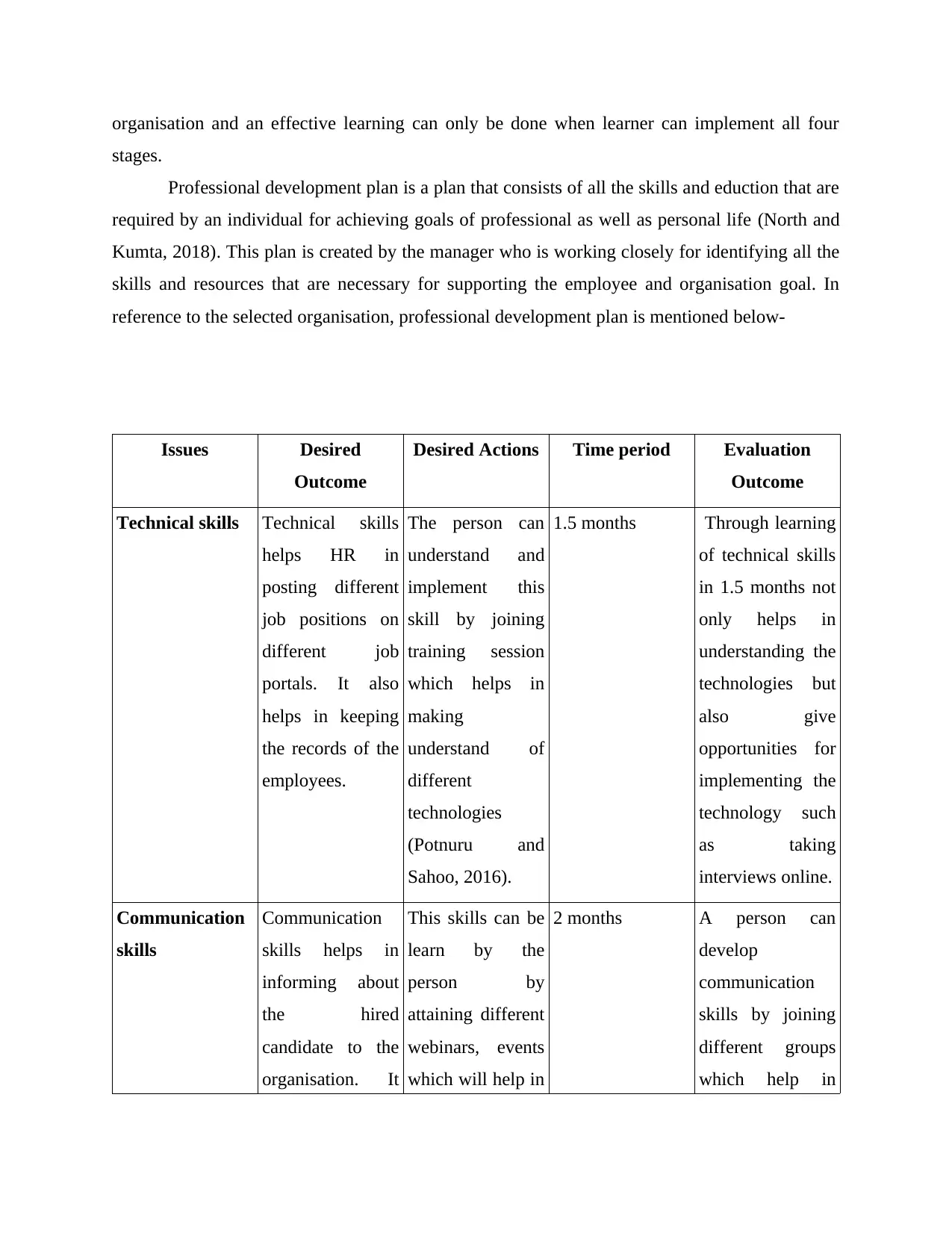
organisation and an effective learning can only be done when learner can implement all four
stages.
Professional development plan is a plan that consists of all the skills and eduction that are
required by an individual for achieving goals of professional as well as personal life (North and
Kumta, 2018). This plan is created by the manager who is working closely for identifying all the
skills and resources that are necessary for supporting the employee and organisation goal. In
reference to the selected organisation, professional development plan is mentioned below-
Issues Desired
Outcome
Desired Actions Time period Evaluation
Outcome
Technical skills Technical skills
helps HR in
posting different
job positions on
different job
portals. It also
helps in keeping
the records of the
employees.
The person can
understand and
implement this
skill by joining
training session
which helps in
making
understand of
different
technologies
(Potnuru and
Sahoo, 2016).
1.5 months Through learning
of technical skills
in 1.5 months not
only helps in
understanding the
technologies but
also give
opportunities for
implementing the
technology such
as taking
interviews online.
Communication
skills
Communication
skills helps in
informing about
the hired
candidate to the
organisation. It
This skills can be
learn by the
person by
attaining different
webinars, events
which will help in
2 months A person can
develop
communication
skills by joining
different groups
which help in
stages.
Professional development plan is a plan that consists of all the skills and eduction that are
required by an individual for achieving goals of professional as well as personal life (North and
Kumta, 2018). This plan is created by the manager who is working closely for identifying all the
skills and resources that are necessary for supporting the employee and organisation goal. In
reference to the selected organisation, professional development plan is mentioned below-
Issues Desired
Outcome
Desired Actions Time period Evaluation
Outcome
Technical skills Technical skills
helps HR in
posting different
job positions on
different job
portals. It also
helps in keeping
the records of the
employees.
The person can
understand and
implement this
skill by joining
training session
which helps in
making
understand of
different
technologies
(Potnuru and
Sahoo, 2016).
1.5 months Through learning
of technical skills
in 1.5 months not
only helps in
understanding the
technologies but
also give
opportunities for
implementing the
technology such
as taking
interviews online.
Communication
skills
Communication
skills helps in
informing about
the hired
candidate to the
organisation. It
This skills can be
learn by the
person by
attaining different
webinars, events
which will help in
2 months A person can
develop
communication
skills by joining
different groups
which help in
⊘ This is a preview!⊘
Do you want full access?
Subscribe today to unlock all pages.

Trusted by 1+ million students worldwide
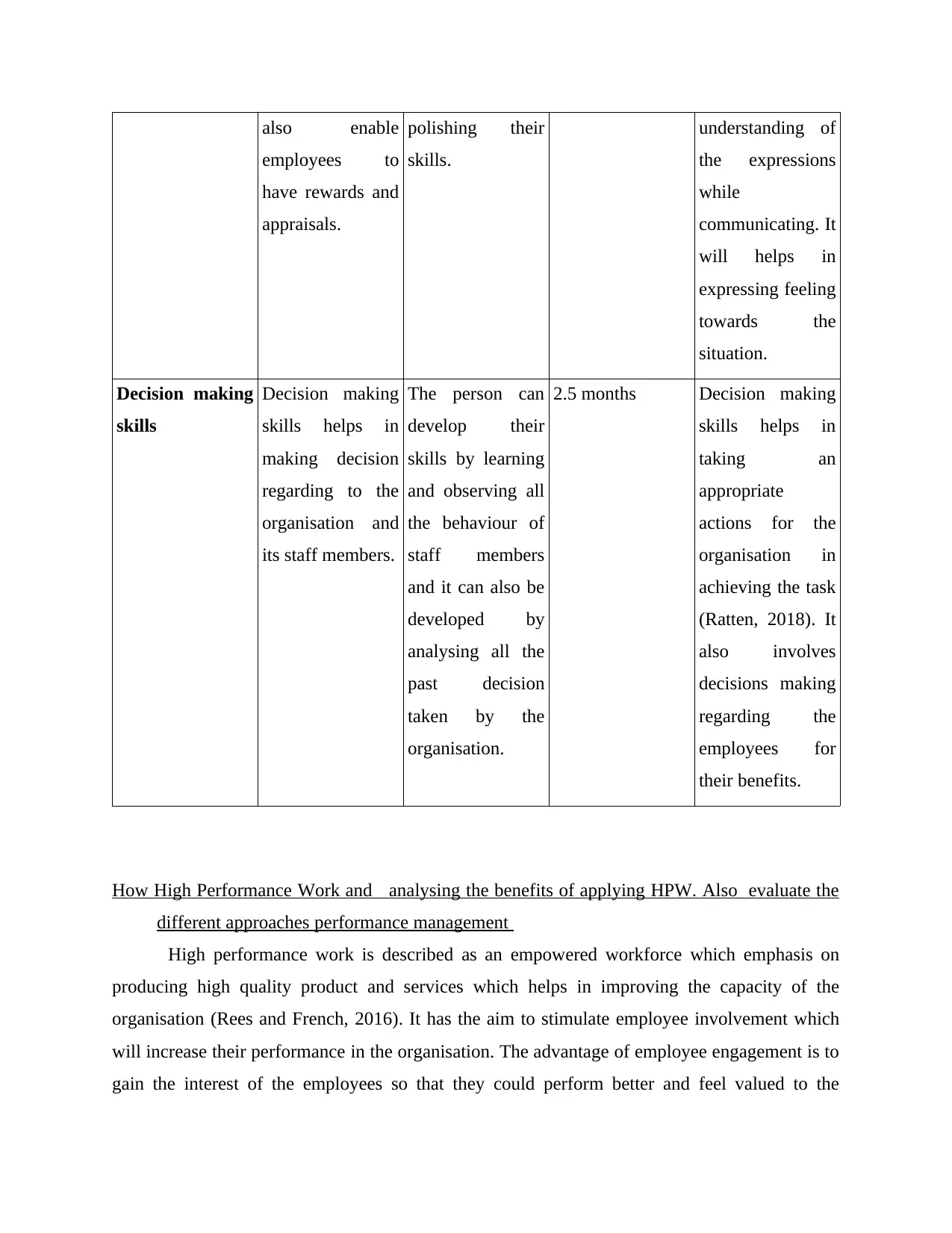
also enable
employees to
have rewards and
appraisals.
polishing their
skills.
understanding of
the expressions
while
communicating. It
will helps in
expressing feeling
towards the
situation.
Decision making
skills
Decision making
skills helps in
making decision
regarding to the
organisation and
its staff members.
The person can
develop their
skills by learning
and observing all
the behaviour of
staff members
and it can also be
developed by
analysing all the
past decision
taken by the
organisation.
2.5 months Decision making
skills helps in
taking an
appropriate
actions for the
organisation in
achieving the task
(Ratten, 2018). It
also involves
decisions making
regarding the
employees for
their benefits.
How High Performance Work and analysing the benefits of applying HPW. Also evaluate the
different approaches performance management
High performance work is described as an empowered workforce which emphasis on
producing high quality product and services which helps in improving the capacity of the
organisation (Rees and French, 2016). It has the aim to stimulate employee involvement which
will increase their performance in the organisation. The advantage of employee engagement is to
gain the interest of the employees so that they could perform better and feel valued to the
employees to
have rewards and
appraisals.
polishing their
skills.
understanding of
the expressions
while
communicating. It
will helps in
expressing feeling
towards the
situation.
Decision making
skills
Decision making
skills helps in
making decision
regarding to the
organisation and
its staff members.
The person can
develop their
skills by learning
and observing all
the behaviour of
staff members
and it can also be
developed by
analysing all the
past decision
taken by the
organisation.
2.5 months Decision making
skills helps in
taking an
appropriate
actions for the
organisation in
achieving the task
(Ratten, 2018). It
also involves
decisions making
regarding the
employees for
their benefits.
How High Performance Work and analysing the benefits of applying HPW. Also evaluate the
different approaches performance management
High performance work is described as an empowered workforce which emphasis on
producing high quality product and services which helps in improving the capacity of the
organisation (Rees and French, 2016). It has the aim to stimulate employee involvement which
will increase their performance in the organisation. The advantage of employee engagement is to
gain the interest of the employees so that they could perform better and feel valued to the
Paraphrase This Document
Need a fresh take? Get an instant paraphrase of this document with our AI Paraphraser
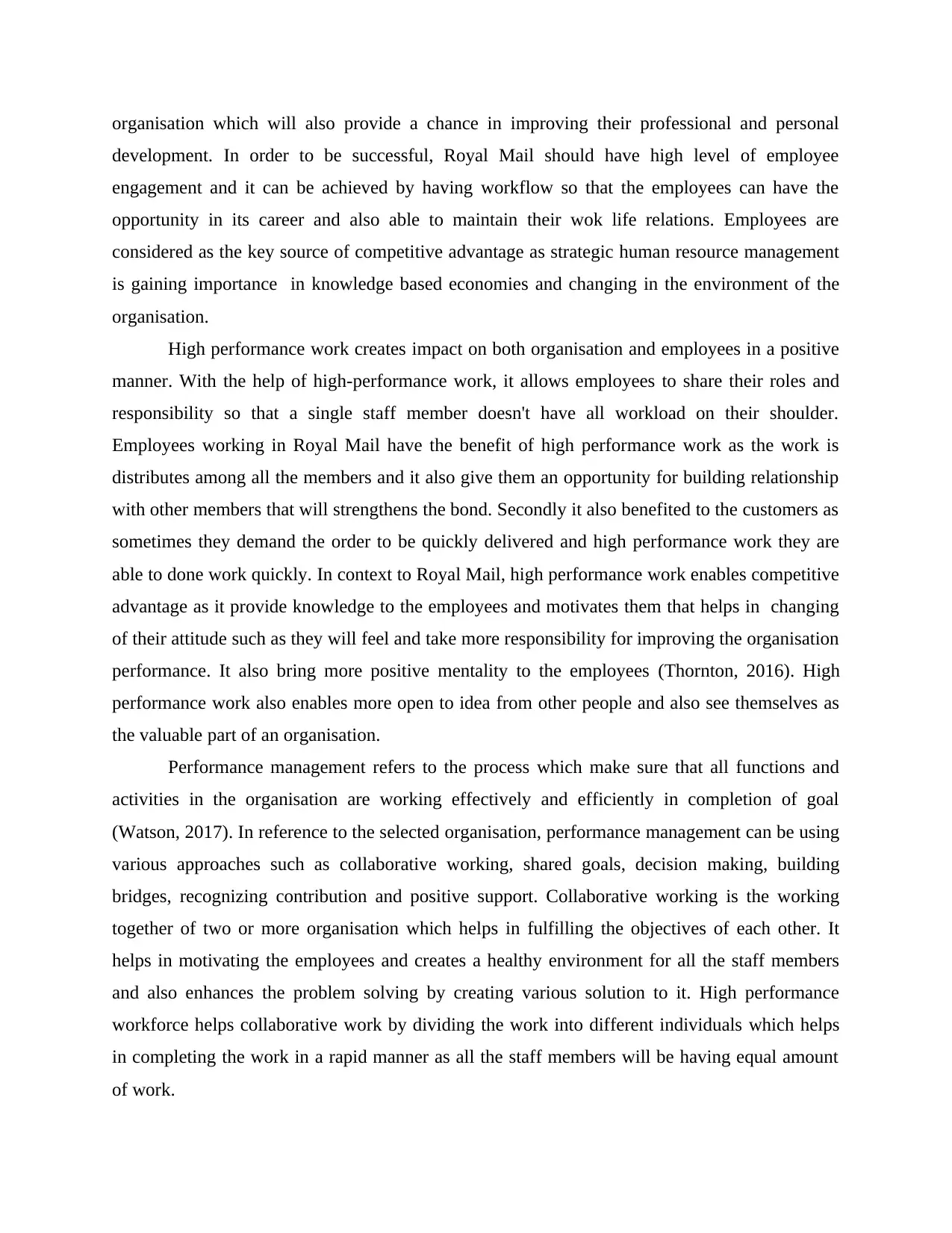
organisation which will also provide a chance in improving their professional and personal
development. In order to be successful, Royal Mail should have high level of employee
engagement and it can be achieved by having workflow so that the employees can have the
opportunity in its career and also able to maintain their wok life relations. Employees are
considered as the key source of competitive advantage as strategic human resource management
is gaining importance in knowledge based economies and changing in the environment of the
organisation.
High performance work creates impact on both organisation and employees in a positive
manner. With the help of high-performance work, it allows employees to share their roles and
responsibility so that a single staff member doesn't have all workload on their shoulder.
Employees working in Royal Mail have the benefit of high performance work as the work is
distributes among all the members and it also give them an opportunity for building relationship
with other members that will strengthens the bond. Secondly it also benefited to the customers as
sometimes they demand the order to be quickly delivered and high performance work they are
able to done work quickly. In context to Royal Mail, high performance work enables competitive
advantage as it provide knowledge to the employees and motivates them that helps in changing
of their attitude such as they will feel and take more responsibility for improving the organisation
performance. It also bring more positive mentality to the employees (Thornton, 2016). High
performance work also enables more open to idea from other people and also see themselves as
the valuable part of an organisation.
Performance management refers to the process which make sure that all functions and
activities in the organisation are working effectively and efficiently in completion of goal
(Watson, 2017). In reference to the selected organisation, performance management can be using
various approaches such as collaborative working, shared goals, decision making, building
bridges, recognizing contribution and positive support. Collaborative working is the working
together of two or more organisation which helps in fulfilling the objectives of each other. It
helps in motivating the employees and creates a healthy environment for all the staff members
and also enhances the problem solving by creating various solution to it. High performance
workforce helps collaborative work by dividing the work into different individuals which helps
in completing the work in a rapid manner as all the staff members will be having equal amount
of work.
development. In order to be successful, Royal Mail should have high level of employee
engagement and it can be achieved by having workflow so that the employees can have the
opportunity in its career and also able to maintain their wok life relations. Employees are
considered as the key source of competitive advantage as strategic human resource management
is gaining importance in knowledge based economies and changing in the environment of the
organisation.
High performance work creates impact on both organisation and employees in a positive
manner. With the help of high-performance work, it allows employees to share their roles and
responsibility so that a single staff member doesn't have all workload on their shoulder.
Employees working in Royal Mail have the benefit of high performance work as the work is
distributes among all the members and it also give them an opportunity for building relationship
with other members that will strengthens the bond. Secondly it also benefited to the customers as
sometimes they demand the order to be quickly delivered and high performance work they are
able to done work quickly. In context to Royal Mail, high performance work enables competitive
advantage as it provide knowledge to the employees and motivates them that helps in changing
of their attitude such as they will feel and take more responsibility for improving the organisation
performance. It also bring more positive mentality to the employees (Thornton, 2016). High
performance work also enables more open to idea from other people and also see themselves as
the valuable part of an organisation.
Performance management refers to the process which make sure that all functions and
activities in the organisation are working effectively and efficiently in completion of goal
(Watson, 2017). In reference to the selected organisation, performance management can be using
various approaches such as collaborative working, shared goals, decision making, building
bridges, recognizing contribution and positive support. Collaborative working is the working
together of two or more organisation which helps in fulfilling the objectives of each other. It
helps in motivating the employees and creates a healthy environment for all the staff members
and also enhances the problem solving by creating various solution to it. High performance
workforce helps collaborative work by dividing the work into different individuals which helps
in completing the work in a rapid manner as all the staff members will be having equal amount
of work.
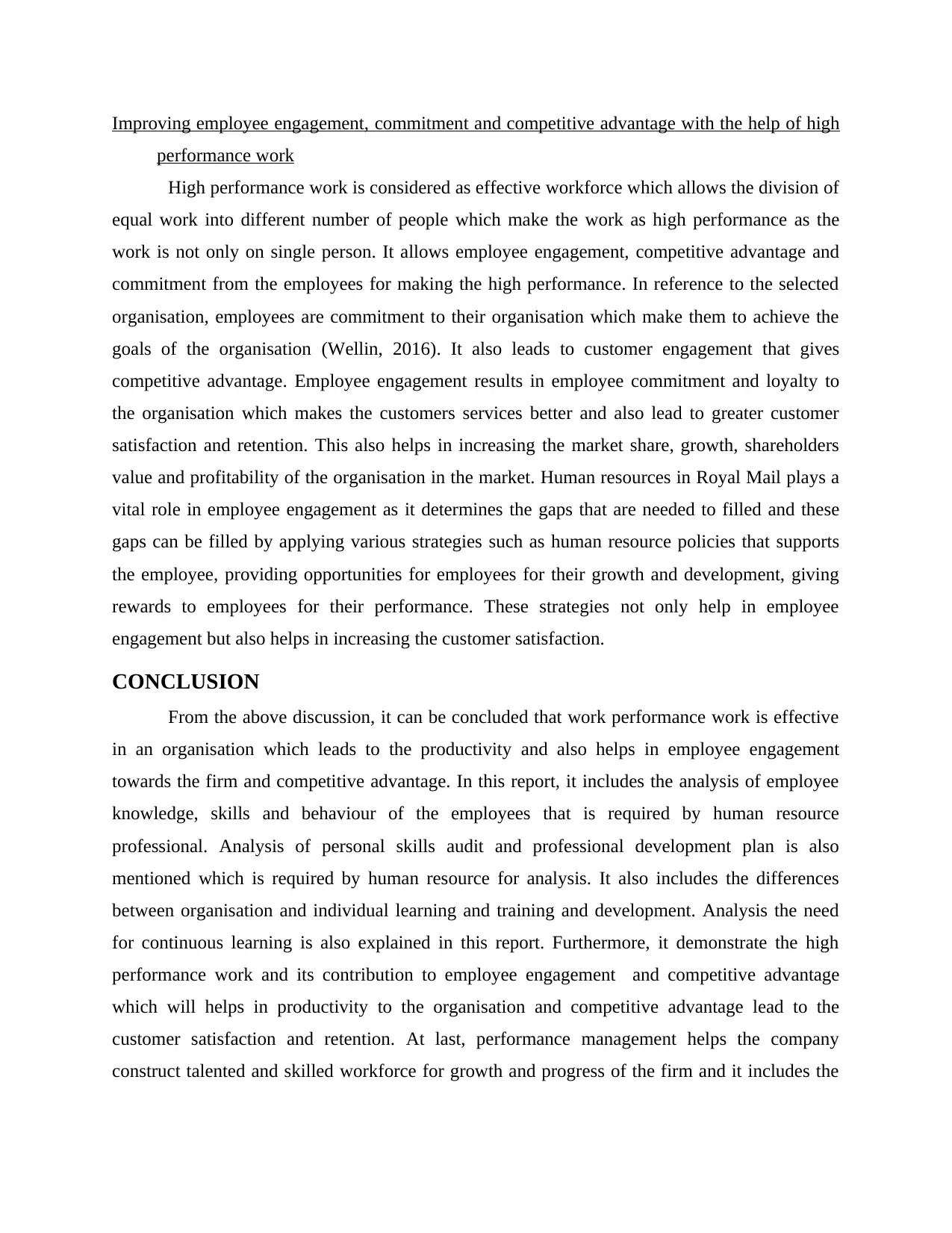
Improving employee engagement, commitment and competitive advantage with the help of high
performance work
High performance work is considered as effective workforce which allows the division of
equal work into different number of people which make the work as high performance as the
work is not only on single person. It allows employee engagement, competitive advantage and
commitment from the employees for making the high performance. In reference to the selected
organisation, employees are commitment to their organisation which make them to achieve the
goals of the organisation (Wellin, 2016). It also leads to customer engagement that gives
competitive advantage. Employee engagement results in employee commitment and loyalty to
the organisation which makes the customers services better and also lead to greater customer
satisfaction and retention. This also helps in increasing the market share, growth, shareholders
value and profitability of the organisation in the market. Human resources in Royal Mail plays a
vital role in employee engagement as it determines the gaps that are needed to filled and these
gaps can be filled by applying various strategies such as human resource policies that supports
the employee, providing opportunities for employees for their growth and development, giving
rewards to employees for their performance. These strategies not only help in employee
engagement but also helps in increasing the customer satisfaction.
CONCLUSION
From the above discussion, it can be concluded that work performance work is effective
in an organisation which leads to the productivity and also helps in employee engagement
towards the firm and competitive advantage. In this report, it includes the analysis of employee
knowledge, skills and behaviour of the employees that is required by human resource
professional. Analysis of personal skills audit and professional development plan is also
mentioned which is required by human resource for analysis. It also includes the differences
between organisation and individual learning and training and development. Analysis the need
for continuous learning is also explained in this report. Furthermore, it demonstrate the high
performance work and its contribution to employee engagement and competitive advantage
which will helps in productivity to the organisation and competitive advantage lead to the
customer satisfaction and retention. At last, performance management helps the company
construct talented and skilled workforce for growth and progress of the firm and it includes the
performance work
High performance work is considered as effective workforce which allows the division of
equal work into different number of people which make the work as high performance as the
work is not only on single person. It allows employee engagement, competitive advantage and
commitment from the employees for making the high performance. In reference to the selected
organisation, employees are commitment to their organisation which make them to achieve the
goals of the organisation (Wellin, 2016). It also leads to customer engagement that gives
competitive advantage. Employee engagement results in employee commitment and loyalty to
the organisation which makes the customers services better and also lead to greater customer
satisfaction and retention. This also helps in increasing the market share, growth, shareholders
value and profitability of the organisation in the market. Human resources in Royal Mail plays a
vital role in employee engagement as it determines the gaps that are needed to filled and these
gaps can be filled by applying various strategies such as human resource policies that supports
the employee, providing opportunities for employees for their growth and development, giving
rewards to employees for their performance. These strategies not only help in employee
engagement but also helps in increasing the customer satisfaction.
CONCLUSION
From the above discussion, it can be concluded that work performance work is effective
in an organisation which leads to the productivity and also helps in employee engagement
towards the firm and competitive advantage. In this report, it includes the analysis of employee
knowledge, skills and behaviour of the employees that is required by human resource
professional. Analysis of personal skills audit and professional development plan is also
mentioned which is required by human resource for analysis. It also includes the differences
between organisation and individual learning and training and development. Analysis the need
for continuous learning is also explained in this report. Furthermore, it demonstrate the high
performance work and its contribution to employee engagement and competitive advantage
which will helps in productivity to the organisation and competitive advantage lead to the
customer satisfaction and retention. At last, performance management helps the company
construct talented and skilled workforce for growth and progress of the firm and it includes the
⊘ This is a preview!⊘
Do you want full access?
Subscribe today to unlock all pages.

Trusted by 1+ million students worldwide
1 out of 14
Related Documents
Your All-in-One AI-Powered Toolkit for Academic Success.
+13062052269
info@desklib.com
Available 24*7 on WhatsApp / Email
![[object Object]](/_next/static/media/star-bottom.7253800d.svg)
Unlock your academic potential
Copyright © 2020–2025 A2Z Services. All Rights Reserved. Developed and managed by ZUCOL.


